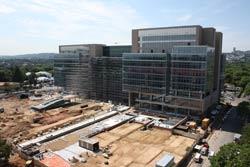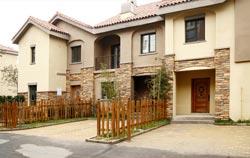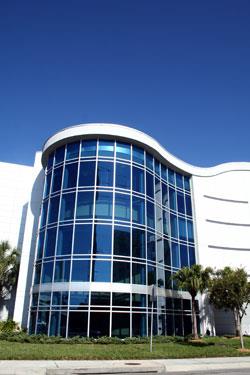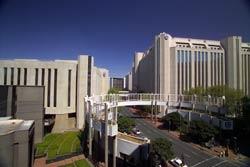In 2004, Johannesburg Stock Exchange listed financial services company and one of South Africa’s big four banks, Standard Bank bought the building known as 30 Baker Street located at the corner of Baker and Oxford Roads in Rosebank, which had at some stage previously was occupied by IBM.

The new R65 000 square metre property named Standard Bank Rosebank has been awarded a five star design rating by the Green Building Council of South Africa (GBCSA) and is set to drive growth and development in this fast emerging and developing business hub.
According to Stewart Shaw-Taylor, head of Corporate Investment Bank real estate at Standard Bank, this was one of the three properties on the site.
The other two properties were then acquired over the period to 2008 leading to a site assembly and rezoning enabling construction to commence in 2009, says Shaw-Taylor.
“It was clear from the bank that the Johannesburg CBD head office was not coping with the staff capacity and needed an office to bring together employees currently in rented properties.”
He explains that the bank adopted a three site strategy which means that the Standard Bank property in the CBD will be operation type business, the new Rosebank property will be a client type centre and the Constantia Valley Office Park in Roodepoort will be for recovery and collection business.
Shaw-Taylor says the head office will remain in the Johannesburg CBD complex, home to 15 500 employees and occupies approximately 200 000 square metres.
The benefit of this three node campus strategy is the elimination of concentration risk in one location and enhanced business continuity in the event of problems experienced at any one of the nodes, points out Shaw-Taylor.
Shaw-Taylor says it made better economic sense to build new offices in line with the bank’s growing requirements thus eliminating rental costs for buildings that are leased by Standard Bank.
“It also made good business sense to build in a suburban location closer to our large clients who had moved out of the CBD and into Rosebank and surrounding areas.”
He says Rosebank is easily one of the most accessible areas in Johannesburg, through the completion of the Gautrain link, taxis, highways and its prime position.

Inclusive of land and the building, the property costs in excess of R2 billion.
“Today Rosebank stands out as one of the most thriving development nodes in Johannesburg, and the third high-rise business district after Sandton and the inner-city of Johannesburg,” says Shaw-Taylor.
Buying property in Rosebank
Asked about the cost of the property, Shaw-Taylor says inclusive of land and the building, the property costs in excess of R2 billion.
The new R65 000 square metre property named Standard Bank Rosebank has been awarded a five star design rating by the Green Building Council of South Africa (GBCSA) and is set to drive growth and development in this fast emerging and developing business hub.
According to Rory Roriston, Standard Bank head of real estate asset management, a four star rating was targeted and Standard Bank is still on track to achieve this in terms of the final As Built certification.
The property is due for completion in May 2013, which is when the first of approximately 5 000 client-facing staff will start to occupy the premises in a phased-in relocation process.
“Rosebank is turning into one of Johannesburg’s fastest growing development nodes and the near completion of Standard Bank Rosebank marks another milestone, talking to investment that has happened in property developments in Rosebank in recent years,” says Shaw-Taylor.
According to Windeed, a sales analysis of 45 properties in Rosebank reveals that the highest priced property has a price tag of R543 620 575 with a R22 101 per square metre, the average price R44 683 058 and R15 026 per square metre and the lowest price has a price tag of R2 million and R1 947 per square metre.
From the report, it seems not a lot of property changed hands in 2012, probably because with the developments taking place in that area, homeowners do not see the reason to sell.

Interestingly, the average price of sectional title properties increased to R1.6 million in November with four sales being concluded and in December it came down to R1.4 million and only one sale took place and in January 2013, the average price of a sectional title property was R915 000 and two properties were sold.
In March 2012, there was only one freehold property (commercial) sold in Rosebank and the average price was R543 620 575 and four sectional title properties with an average price of R1.3 million.
In October 2012, a freehold property was sold with an average price of R3.55 million and six sectional title properties averaging R1.13 million.
Interestingly, the average price of sectional title properties increased to R1.6 million in November with four sales being concluded and in December it came down to R1.4 million and only one sale took place and in January 2013, the average price of a sectional title property was R915 000 and two properties were sold.
Windeed reveals that in 2008, the average price of a freehold property was R27 252 708 (eight sold), while sectional title was R4.2 million (50 sold), in 2009, freehold properties’ average fell to R5.875 million (14 sold), sectional title fell below the million Rand mark to R850 000 (29 sold), in 2010, the average price fell further to R710 064 (39 sold) and managed to pick up again in 2011 to average R950 000 (32 sold).
Meanwhile, freehold properties grew to an average of R15 212 500 (16 sold) and the average price dropped to R11.628 million with 12 properties sold.
Get a Windeed report here and find property for sale in Rosebank here.
According to the Jones Lang LaSalle Johannesburg Real Estate Overview Q4 2012, the first quarter of 2013 will see the completion of two buildings in Rosebank, the Standard Bank Rosebank at the corner of Baker and Oxford Road, 30 Jellicoe Avenue measuring 10 000 square metres and the redeveloped prime office space of 4 500 square metres by Old Mutual in the Rosebank was finally taken up by various companies during this period.
Furthermore, the report reveals that in the quarter, a number of notable deals were indicative of companies moving within the nodes in search of better quality buildings.

Much like the past two years, demand for office space is still driven largely by consolidation and building efficiencies, according to Jones Lang LaSalle.
Much like the past two years, demand for office space is still driven largely by consolidation and building efficiencies, according to Jones Lang LaSalle.
“Standard Bank’s new offices in Rosebank are a physical manifestation of the sustainability we aim for at every level of our business," says Shaw-Taylor.
Green features
Roriston explains that the property is built on land that had been used for business purposes before and it consists of two footprint buildings of nine and 11 floors, east and west of a central multi-volume atrium and on top of five basement levels offering 3 915 parking bays.
It incorporates energy demands with seamless technology aimed at balancing an effective working environment and reducing carbon footprint, he says.
The GBCSA has revealed that in green and friendly office properties, there is increased productivity due to enhanced ventilation, temperature and lighting control, as well as daylight and the absence of toxic materials result in increased health, comfort and wellbeing of building occupants.
He explains that the property is designed to provide an efficient, effective and expressive work environment that supports changing work processes, meets the business objectives and strategies of management, and adds value to the performance and wellbeing of employees.
“Space planning is therefore designed to encourage greater levels of collaboration, greater sharing of knowledge, and greater interaction across different workgroups.”
Water will be conserved inside the building through water efficient fittings such as dual flush toilets, low flow shower heads and tap aerators while rain water harvesting alone will reduce potable water demand by 56 percent.
Roriston says the property makes use of a gas powered tri-generation plant - the simultaneous production of electrical energy and heat and cooling from a single energy source such as natural gas.
It is commonly referred to as CCHP (combined cooling, heating, and power generation) and the bank is the second company in South Africa to have this technology, MTN has this technology at their main head office in Roodepoort.
“At a production capacity of 1MW of energy, it will significantly reduce the building’s carbon footprint while the rejected heat emitted by the plant will provide 0.8MW of energy that will be used for heating and cooling,” says Roriston.

Shaw-Taylor says the head office will remain in the Johannesburg CBD complex, home to 15 500 employees and occupies approximately 200 000 square metres.
Further energy savings will be achieved through efficient lighting.
He notes that the lighting power density has been reduced to below 2.5W per square metre per 100 Lux.
A digitally addressable lighting system has been installed for 99.26 percent of the usable area.
This allows individual light fittings to be programmed according to need, and facilitates automatic dimming and switching of lighting based on occupancy and daylight availability in the space, he says.
No light beam on the piazza or in the garden is directed into the night sky, so external light pollution is minimised.
The property features a ground floor restaurant, meeting centre, multiple pause areas and meeting spaces lining the upper levels of the atrium, which add to the interior and piazza activity.
A rugby-sized urban garden incorporating 422 trees, indigenous flower gardens, and lawn areas has been created on a super-basement above five floors of parking, he says.
An interesting feature is the glass curtain wall system, triple glazed with built-in remotely activated shading blinds.
The blinds can be retracted into the framing system to enable maximum natural light on cloudy days.
He adds that the aspect of transparency in the use of the glass curtain walls and the expansive atria is reinforced internally through the use of clear glass and screening devices that define spaces while providing a sense of privacy. – Denise Mhlanga









